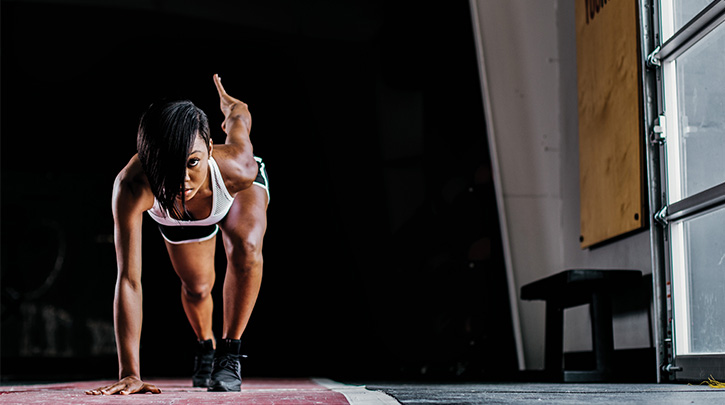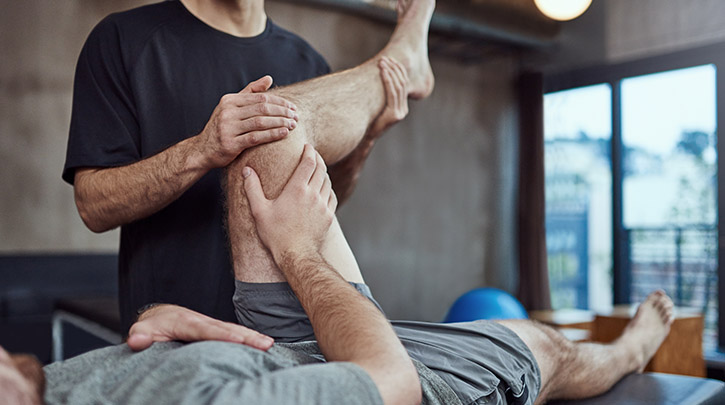
- Global
Get non-surgical solutions for today's top aesthetic concerns with Venus Treatments. Join thousands of satisfied patients worldwide!
- Loading...
- All Regions
Get non-surgical solutions for today's top aesthetic concerns with Venus Treatments. Join thousands of satisfied patients worldwide!

While soft tissue injuries can occur anywhere and at any time—from simple repetitive tasks at your desk at work to a sprain when stepping out of your car or losing your footing—sports are without a doubt one of the most common causes. However, knowing the most common types of sports-related injuries to watch out for and how to treat them quickly and effectively when they do crop up can help to ensure they don’t slow you down long-term. The following are the five most common types of injuries in sports, according to the American Academy of Orthopaedic Surgeons (AAOS).
First up are sprains, a common occurrence that may easily heal with the right treatment but that can be otherwise quite severe. Sprains result from the stretching or tearing of a ligament, which is a fairly strong connective tissue band that connects bones. Responsible for providing additional support to joints and flexibility to our bone structure, much of our ability to walk, run, jump, and move can be attributed to ligaments.
The most vulnerable areas for sprains in sports are the wrists, knees, and ankles. Sudden twists, imbalances, and extreme or sudden tension are all factors contributing to an increased risk of a sprain in sports. The intensity of sprains can vary from grade 1 (mild with a slight overstretching of the ligament) to grade 3 (severe with a tear in a ligament), but all grades of sprains have bruising, swelling, and inflammation in common.
Like sprains, strains can range from mild overstretching to partial or complete tears. Unlike sprains, strains are injuries to muscles and tendons. Muscles are the soft connective tissue responsible for contractions, while tendons are fibrous tissue that attach muscles to bones. Sports-related strains most commonly occur in the foot, leg, or back. Common symptoms of strains include muscle spasm or weakness, swelling, cramping in the muscle, inflammation, and pain.
Strains are often experienced in sports that require more contact, such as football, hockey, and wrestling, as well as sports that require speedy starts, like sprinting, hurdling, or long jump. In comparison, those who participate in gymnastics, rowing, or tennis, among other sports, may experience strains more often concentrated in the hands, wrists, and elbows.
Bruises resulting from direct, repeated impact are called contusions. In the instance a contusion occurs, the impacted muscles and connective tissue are essentially crushed without the skin being broken. Common in contact sports such as boxing, rugby, or hockey, contusions are generally mild and are characterized by pain and pooling of blood under the skin’s surface, usually resulting in a brown, blue, or purple appearance. While most sports-related contusions are of little concern and will heal in due time, if symptoms continue without decline, medical intervention may be needed to ensure the damaged soft tissue fully recovers.
A common injury linked to overuse, tendinitis is characterized by pain and inflammation in the tendon. Generally speaking, overuse injuries result from continuous small stresses placed on a tendon that cause cumulative aggravation, leading to swelling and pain. Jumper’s or runner’s knee, common in soccer and basketball players, runners, and hurdlers, is one common example, while tennis elbow might be the most common, accounting for about seven percent of all sport-related injuries. Golfers, baseball players, and swimmers are also susceptible to tendinitis injuries in the shoulders. In fact, the core symptoms of tendinitis are pain and swelling that may gradually worsen with increased activity. If tendinitis injuries persist, they may develop into tendinosis, a chronic (recurring) soft tissue condition resulting from repetitive trauma on an injury that has not had time to heal.
Bursitis and tendinitis may commonly be confused when judging symptoms alone, so an MRI scan may be required to correctly identify bursitis. This particular sports-related injury occurs in the bursae, which are small, jelly-like pockets that contain fluid and act as cushions between bones and soft tissues to reduce friction. Bursitis occurs when repetitive stress and overuse causes bursa to become inflamed. Pain and swelling are the most commonly experienced symptoms. While bursae are located throughout the body, some areas in which bursitis most commonly occurs for athletes include the heels, knees, hips, shoulders, and elbows.
In all of the above injuries, pain and inflammation can impede recovery. Inflammation directly affects free blood flow to the injured area, restricting the delivery of oxygen and healing nutrients to damaged soft tissue and slowing reparation. Further, chronic pain can limit movement and reduce the likelihood of recovering complete range of motion.
To help speed up recovery and get you back to enjoying your sport of choice faster, consider adding radio frequency-based Venus Heal™ soft tissue injury treatments to your rehabilitation plan. Utilizing synergistic Multi-Polar Radio Frequency (RF) and Pulsed Electro Magnetic Field (PEMF) technologies alongside therapeutic massage, these treatments deliver targeted thermal (heat) energy deep below the skin’s surface to damaged soft tissue. This stimulates the body’s natural soft tissue repair cycle, while releasing tension and relieving pain. The overall result is a reduction in pain (sometimes noticed in as little as one treatment), reduced inflammation, improved local blood circulation, and optimal recovery in range of motion for a faster recovery period and a more successful outcome as compared to more traditional therapies alone. Venus Heal™ treatments may also be paired with a host of other soft tissue treatment technologies for a perfectly customized treatment plan that meets your unique rehabilitation needs.
Interested in learning more about how Venus Heal™ soft tissue injury treatments could help speed up your recovery? Get the details alongside your customized treatment plan from a certified treatment provider near you.
Find a certified Venus Treatments provider near you today who specializes in today’s top aesthetic medical solutions.



Search below to find a provider near you and to learn about our non-surgical aesthetic treatments with ARTAS®, NeoGraft®, Venus Bliss™, Venus Blilss MAX™, Venus Versa™, Venus Legacy™ Venus Versa™ Pro, Venus Velocity™, Venus Viva™ MD, and Venus Glow™.
For more information call: (888) 907-0115 // [email protected] // 235 Yorkland Blvd., Suite 900, Toronto, ON, M2J 4Y8 Canada
REGULATORY CLEARANCES [ More ]
Venus Bliss™ is cleared by the FDA and licensed by Health Canada for non-invasive lipolysis of the abdomen and flanks in individuals with a Body Mass Index (BMI) of 30 or less, with the diode laser applicators. The (MP)2 applicator is cleared by the FDA for temporary reduction in the appearance of cellulite, and licensed by Health Canada for temporary increase of skin tightening, temporary circumferential reduction, and temporary cellulite reduction. Venus Bliss™ has CE Mark as a non-invasive medical aesthetic device enabling a comprehensive approach leading to body contouring, addressing fat reduction, skin tightening, circumference reduction, and cellulite reduction.
Venus Versa™ is cleared by the FDA, licensed by Health Canada, and has CE Mark as a multi-application device intended to be used in aesthetic and cosmetic procedures. The SR515 and SR580 applicators are cleared by the FDA, licensed by Health Canada, and have CE Mark for the treatment of benign pigmented epidermal and cutaneous lesions and treatment of benign cutaneous vascular lesions. The HR650/HR650XL and HR690/HR690XL applicators are cleared by the FDA, licensed by Health Canada, and have CE Mark for the removal of unwanted hair and to effect stable long-term or permanent hair reduction for Fitzpatrick skin types I-IV. The AC Dual applicator is cleared by the FDA, licensed by Health Canada, and has CE Mark for the treatment of acne vulgaris. The DiamondPolar™ and OctiPolar™ applicators on the Venus Versa™ system are cleared by the FDA for non-invasive treatment of moderate to severe facial wrinkles and rhytides on females with Fitzpatrick skin types I-IV. The DiamondPolar™ applicator is licensed by Health Canada and has CE Mark for non-invasive treatment of moderate to severe facial wrinkles and rhytides on females with Fitzpatrick skin types I-IV. The OctiPolar™ applicator on the Venus Versa™ system is licensed by Health Canada and has CE Mark for temporary body contouring via skin tightening, circumferential reduction, and cellulite reduction. The NanoFractional RF™ (Viva) applicator is cleared by the FDA, licensed by Health Canada, and has CE Mark for dermatological procedures requiring ablation and resurfacing of the skin.
NeoGraft® is cleared by the FDA, licensed by Health Canada and has CE Mark with indication for use in suction-assisted follicular extraction and re-implantation. It is an auto-graft system and can be used on both male and female patients.
ARTAS iX™ is cleared by the FDA, licensed by Health Canada and has CE Mark with indication for use for harvesting hair follicles from the scalp in men diagnosed with androgenic alopecia (male pattern hair loss) who have black or brown straight hair. ARTAS iX™ is intended to assist physicians in identifying and extracting hair follicular units from the scalp during hair transplantation; creating recipient sites; and implanting harvested hair follicles.
Venus Legacy™ is cleared by the FDA for the non-invasive treatment of moderate to severe facial wrinkles and rhytides in females with Fitzpatrick skin types I-IV with the OctiPolar™ and DiamondPolar™ applicators, and temporary reduction in the appearance of cellulite with the 4D Body (LB2) and 4D Face (LF2) applicators. It is licensed by Health Canada and has CE Mark for the temporary increase of skin tightening, temporary circumferential reduction, temporary cellulite reduction, and temporary wrinkle reduction.
Venus Velocity™ is cleared by the FDA, licensed by Health Canada and has CE Mark for hair removal, permanent hair reduction (defined as the long-term stable reduction in the number of hairs re-growing when measured at 6, 9 and 12 months after the completion of a treatment regimen), and the treatment of pseudofolliculitis barbae for all Fitzpatrick skin types.
Venus Fiore™ received regulatory approval in Israel for aesthetic and functional treatment of the vagina, labia and mons pubis. Venus Fiore™ is available for sale in India, Hong Kong, and other selected Asian countries.
Venus Viva™ is cleared by the FDA, licensed by Health Canada, and has CE Mark for dermatological procedures requiring ablation and resurfacing of the skin. The DiamondPolar™ applicator is cleared by the FDA, licensed by Health Canada and has CE Mark for the treatment of moderate to severe wrinkles and rhytides in Fitzpatrick skin types I-IV.
Venus Freeze Plus™ is cleared by the FDA for the non-invasive treatment of moderate to severe facial wrinkles and rhytides in females with Fitzpatrick skin types I-IV. It is licensed by Health Canada for temporary skin tightening, and temporary reduction in the appearance of cellulite on the abdomen and flanks, using the DiamondPolar™ and OctiPolar™ applicators. The DiamondPolar™ applicator on Venus Freeze Plus™ has CE Mark for the non-invasive treatment of moderate to severe facial wrinkles and rhytides, and the increase of skin tightening, temporary circumferential reduction, and cellulite reduction with the OctiPolar™ applicator.
Venus Heal™ is licensed by Health Canada and can be used for the treatment of both acute and chronic disorders of the musculoskeletal system, such as muscle spasms, back pain, and soft tissue injuries, and results in effects such as pain relief, myorelaxation, increase of local blood circulation, and edema reduction. In the U.S., Venus Heal™ is cleared by the FDA for the relief of minor muscle aches and pain, relief of muscle spasm, and temporary improvement of local blood circulation. These indications enable the treatment of certain soft tissue injuries and conditions.
Venus Glow™ is cleared by the FDA as a Class I motorized dermabrasion device. It provides a dermal rejuvenation treatment that works to open up and deep-clean pores. Venus Concept is the exclusive distributor for Venus Glow™.
Venus Epileve™ is licensed by Health Canada and has CE Mark for hair removal, permanent hair reduction (defined as the long-term stable reduction in the number of hairs re-growing when measured at 6, 9 and 12 months after the completion of a treatment regimen), and the treatment of pseudofolliculitis barbae for all Fitzpatrick skin types. Venus Epileve™ is also CE-Marked for hirsutism.
Venus Freeze™ is cleared by the FDA for the non-invasive treatment of moderate to severe facial wrinkles and rhytides in females with Fitzpatrick skin types I-IV. It is licensed by Health Canada for temporary skin tightening, and temporary reduction in the appearance of cellulite on the abdomen and flanks, using the DiamondPolar™ and OctiPolar™ applicators. The DiamondPolar™ applicator on Venus Freeze™ has CE Mark for the non-invasive treatment of moderate to severe facial wrinkles and rhytides, and the increase of skin tightening, temporary circumferential reduction, and cellulite reduction with the OctiPolar™ applicator.
Venus Swan™ is cleared by the FDA for the non-invasive treatment of moderate to severe facial wrinkles and rhytides, and licensed by Health Canada for the non-invasive treatment of cellulite reduction, skin tightening, and temporary reduction in the appearance of stretch marks.
Copyright © 2025 Venus Concept. All rights reserved.
You are entering our website. For other countries/regions and language options, please click the SELECT A DIFFERENT REGION button below.
SELECT A DIFFERENT REGIONAre you looking to get a treatment? Please visit our patient website to learn more.
Click HereUnsure which aesthetic treatment is right for you? Take this quick and easy quiz to discover treatments that suit your needs.
Get Started